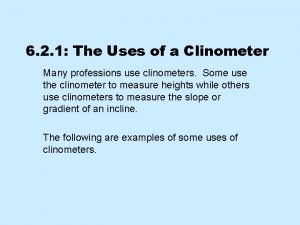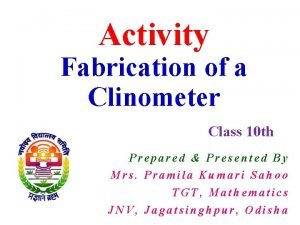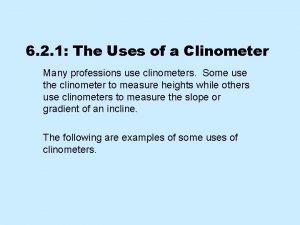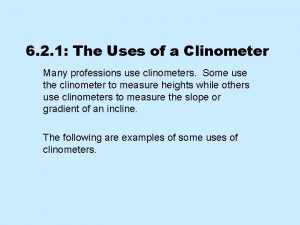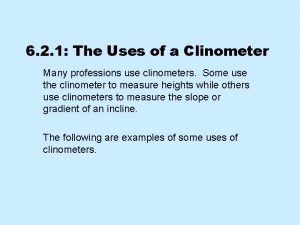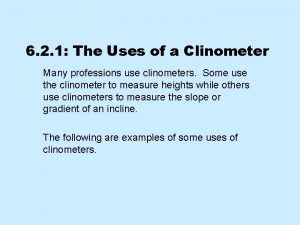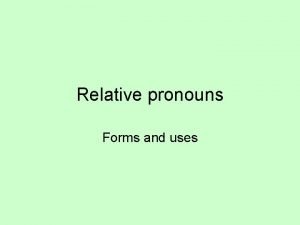6 2 1 The Uses of a Clinometer














- Slides: 14

6. 2. 1: The Uses of a Clinometer Many professions use clinometers. Some use the clinometer to measure heights while others use clinometers to measure the slope or gradient of an incline. The following are examples of some uses of clinometers.

Why Would Geologists and Surveyors Use Clinometers? In their fieldwork, Geologists use clinometers to determine the height of an object (eg: a tree or a mountain) by using the formula: Height = H + D tan. A where: H = height of the clinometer to the ground D = distance of the clinometer to the object A = angle taken from clinometer reading Picture from: http: //www. ukge. co. uk/UK/product. asp? num. Record. Position=1&P_ID =256&str. Page. History=&str. Keywords=&Search. For=&PT_ID=133

Why Would a Skier or Winter Hiker Want to Have a Clinometer With Them? Skiers and winter hikers use a clinometer as a safety device. Snow covered slopes angled between 25 and 45 have a higher risk of avalanches and would therefore be avoided. Picture from: http: //pistehors. com/backcountry/wiki/Gear/Clinometer

Why Would Sailors Want a Clinometer on Their Ship? Sight clinometers are used to determine the height of clouds. Sailors can use them to predict possible dangers from storms. These were more commonly used before, the more accurate, satellite weather monitors were invented. Picture from: http: //www. novalynx. com/400 -2090. html

Why Would Cave Surveyors Use a Clinometer? Inclinometers (another name for a clinometer) are used in cave surveying. The clinometer helps to measure the depth of the cave and horizontal distances throughout the cave. This helps surveyors to create a map of the cave. Picture from: http: //www. nps. gov/wica/naturescience/cave-surveying. htm

Why Would City Planners Need Clinometers? Digital clinometers can be used to assess the conditions of sidewalks and roads. Appropriate slopes of roads and sidewalks are necessary for: - road safety. - appropriate runoff of rain. - accessibility for pedestrians with special needs. Picture from: http: //www. fhwa. dot. gov/environment/sidewalk 2/sidewalks 211

Other Uses of Clinometers • Indicating pitch and roll of vehicles, sail boats, and aircraft. • Monitoring boom angle of cranes and material handlers. • Measuring the "look angle" of a satellite antenna towards a satellite. • Measuring movements in walls and/or the ground in civil engineering projects • Measuring the angle of drilling in well-logging applications. • Rollover warning, to alert equipment operator of possible tip over condition • Determining the angle of the earth's magnetic field in respect to the horizontal plane. • Measuring steepness of a ski slope. (<10 o for beginners, 10 o-20 o "green", 15 o-25 o "blue", 25 o-35 o "black", 35 o-45 o "double black") Information from: http: //en. wikipedia. org/wiki/Clinometer

6. 2. 2: Activity: Measuring the Gradient of a Road • City planners must be careful when building roads and sidewalks to ensure that they are not too steep. Otherwise, they will be dangerous for vehicles and pedestrians. • Vehicles traveling uphill require more energy in order to produce more power. Therefore steeper hills can contribute to more air and sound pollution. • A hills steepness is indicated by it’s gradient. • To measure the gradient of a hill one must find the altitude change (rise) and the horizontal distance (run). The gradient of a hill is the slope (rise/run) as a percentage. e. g. : 5 m ___ Gradient = 56 m X 100% 5 m 56 m = 8. 9%

Activity: Part 1 • You will be part of a group of city planners determining whether or not to build a new road by the school. • You must study each hill in the area to ensure that they are of a safe incline. Otherwise, they will have to be leveled. • It is recommended that hills not exceed a gradient of 10%. Some roads do in fact exceed this gradient. However, with our harsh winters we should avoid this. • In groups of 3 you will be assigned a hill to analyze.

Materials • Home made clinometer • 2 metre sticks • Measuring tape • Paper and pen to write down calculations Picture from: http: //www. state. nj. us/dep/seeds/syhart/clinom. htm

• Person 1 stands on the top of the hill with the metre stick in front of them, perpendicular to the ground. • Person 2 and 3 stand at the bottom of the hill. • Person 2 holds the metre stick perpendicular to the ground while person 3 uses the clinometer to sight from the tip of their metre stick to the tip of the other. ***Ensure your line of sight is parallel to the ground. • Record the angle of inclination from the clinometer • Measure the distance along the ground from the bottom of the hill to the top of the hill.

Line of sight 90 line on protractor weight

Activity: Part 2 • As city planners, you will need to create a scale model of the area. • You know the angle of inclination of the hill (θ) as well as the length of the hill (c). Using this, you will have to calculate the vertical height (a) and horizontal length (b) of the hill. Use trigonometry to do this. Give your results in feet. • You can now use the rise (a) and the run (b) to measure the gradient of the hill. • Your scale model will be 5% of the original size. • Determine the vertical height (a 1) and the horizontal length (b 1) of the scale model of the hill. Give your results in inches. c a θ b

Written Report You will submit a report containing: • A description of where your hill is with reference to the school. • A labeled diagram of your hill. • Calculations of the vertical height and horizontal length of the hill (in feet). • Below your diagram give a brief discussion of whether the hill is safe or not (make reference to the grade). • Calculation of the vertical height and horizontal length of the smaller scale version of the hill (in inches). Note: You will not actually have to construct the scale model, just give calculations for it.
 Clinometer is used for
Clinometer is used for Non precision measuring tools
Non precision measuring tools Clinometer class 10
Clinometer class 10 đặc điểm cơ thể của người tối cổ
đặc điểm cơ thể của người tối cổ Tỉ lệ cơ thể trẻ em
Tỉ lệ cơ thể trẻ em Các châu lục và đại dương trên thế giới
Các châu lục và đại dương trên thế giới ưu thế lai là gì
ưu thế lai là gì Thẻ vin
Thẻ vin Môn thể thao bắt đầu bằng chữ f
Môn thể thao bắt đầu bằng chữ f Tư thế ngồi viết
Tư thế ngồi viết Bàn tay mà dây bẩn
Bàn tay mà dây bẩn Hình ảnh bộ gõ cơ thể búng tay
Hình ảnh bộ gõ cơ thể búng tay Mật thư tọa độ 5x5
Mật thư tọa độ 5x5 Từ ngữ thể hiện lòng nhân hậu
Từ ngữ thể hiện lòng nhân hậu Tư thế ngồi viết
Tư thế ngồi viết
